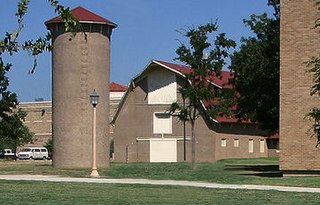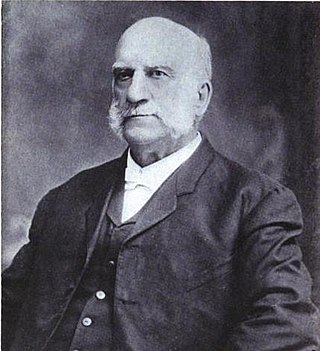
The Morrill Land-Grant Acts are United States statutes that allowed for the creation of land-grant colleges in U.S. states using the proceeds from sales of federally owned land, often obtained from Native American tribes through treaty, cession, or seizure. The Morrill Act of 1862 was enacted during the American Civil War, and the Morrill Act of 1890 expanded this model.

A land-grant university is an institution of higher education in the United States designated by a state to receive the benefits of the Morrill Acts of 1862 and 1890, or a beneficiary under the Equity in Educational Land-Grant Status Act of 1994. There are 57 institutions which fall under the 1862 Act, 19 under the 1890 Act, and 35 under the 1994 Act.

The Texas A&M University System is a state university system in Texas and is one of the state's seven independent university systems.

Texas A&M AgriLife Research is the agricultural and life sciences research agency of the U.S. state of Texas and a part of the Texas A&M University System. Formerly named Texas Agricultural Research Service, the agency's name was changed January 1, 2008, as part of a rebranding of Texas A&M AgriLife. The A&M was formally added to the agency's name on September 1, 2012, as part of a branding effort by the Texas A&M University System to strengthen the association between the agencies and Texas A&M University.

Texas A&M Engineering Extension Service is a state extension agency that offers training programs and technical assistance to public safety workers, both in Texas and around the world. Established in 1940 as the Industrial Extension Service, the agency took on its current name when it joined The Texas A&M University System in 1948. The agency sponsors the state's primary urban search and rescue force, Urban Search and Rescue Texas Task Force 1, and operates the Brayton Fire Training Field. Brayton is the largest firefighting training facility in the United States, and also contains a mock city for conducting training operations for emergency responders.
Agricultural extension is the application of scientific research and new knowledge to agricultural practices through farmer education. The field of 'extension' now encompasses a wider range of communication and learning activities organized for rural people by educators from different disciplines, including agriculture, agricultural marketing, health, and business studies.

Agricultural education is the systematic and organized teaching, instruction and training available to students, farmers or individuals interested in the science, business and technology of agriculture as well as the management of land, environment and natural resources.

The history of Texas A&M University, the first public institution of higher education in Texas, began in 1871, when the Agricultural and Mechanical College of Texas was established as a land-grant college by the Reconstruction-era Texas Legislature. Classes began on October 4, 1876. Although Texas A&M was originally scheduled to be established under the Texas Constitution as a branch of the yet-to-be-created University of Texas, subsequent acts of the Texas Legislature never gave the university any authority over Texas A&M. In 1875, the Legislature separated the administrations of A&M and the University of Texas, which still existed only on paper.

The Illinois Farm Bureau (IFB) is a nonprofit U.S. organization controlled by farmers who join the IFB through one of the 96 county Farm Bureaus in Illinois. The organization's legal name is the Illinois Agricultural Association. The IFB was founded in 1916 by a group of farmers who met at the University of Illinois to discuss the need for agricultural education, better information for farmers, and more effective farming practices. Modernly, the IFB represents two out of three Illinois farmers.

The University of Florida Institute of Food and Agricultural Sciences (UF/IFAS) is a teaching, research and Extension scientific organization focused on agriculture and natural resources. It is a partnership of federal, state, and county governments that includes an Extension office in each of Florida's 67 counties, 12 off-campus research and education centers, five demonstration units, the University of Florida College of Agricultural and Life Sciences, three 4-H camps, portions of the UF College of Veterinary Medicine, the Florida Sea Grant program, the Emerging Pathogens Institute, the UF Water Institute and the UF Genetics Institute.

The Alabama Cooperative Extension System provides educational outreach to the citizens of Alabama on behalf of the state's two land grant universities: Alabama A&M University and Auburn University.
A common perception is that the birth of Cooperative Extension followed the passage of the Smith-Lever Act of 1914, which provided federal funds to land-grant universities to support Extension work. In the formal sense, this is true. Even so, the roots of Cooperative Extension extend as far back as the late 18th century, following the American Revolution, when affluent farmers first began organizing groups to sponsor educational meetings to disseminate useful farming information. In some cases, these lectures were delivered by university professors — a practice that foreshadowed Cooperative Extension work more than a century later.

The New Jersey Agricultural Experiment Station is an entity currently operated by Rutgers, The State University of New Jersey in conjunction with the State of New Jersey in the university's role as the state's sole land-grant university. Today, it conducts research in agriculture, horticulture and turf grass science, and through the Rutgers Cooperative Extension aids New Jersey farmers, landscapers, and residents in each of the state's twenty-one counties.

Seaman Asahel Knapp was a Union College graduate, Phi Beta Kappa member, physician, college instructor, and, later, administrator, who took up farming late in life, moving to Iowa to raise general crops and livestock.
The Arkansas Agricultural Experiment Station (AAES) is the statewide research component of the University of Arkansas System's Division of Agriculture. The Division also includes the Cooperative Extension Service. The AAES and CES work together to develop and test new agricultural technology and extend it to the public. Research faculty and staff are based on five university campuses, at five Research and Extension Centers; six research stations and seven specialized units.
The University of Arkansas System Division of Agriculture is the agricultural research center for the University of Arkansas (UA).
The Penn State College of Agricultural Sciences offers 17 undergraduate majors, 23 minors, and graduate programs in 18 major areas. The college awarded the nation's first baccalaureate degrees in agriculture in 1861.

The Cooperative State Research, Education, and Extension Service (CSREES) was an extension agency within the U.S. Department of Agriculture (USDA), part of the executive branch of the federal government. The 1994 Department Reorganization Act, passed by Congress, created CSREES by combining the former Cooperative State Research Service and the Extension Service into a single agency.












